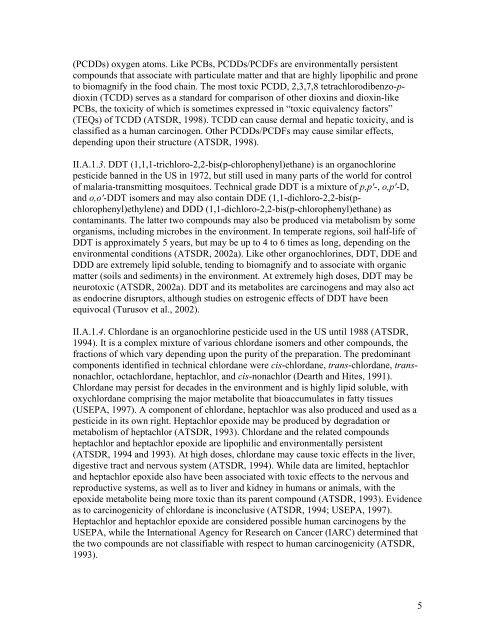Volume III, Appendices EM - National Marine Fisheries Service ...
Volume III, Appendices EM - National Marine Fisheries Service ...
Volume III, Appendices EM - National Marine Fisheries Service ...
Create successful ePaper yourself
Turn your PDF publications into a flip-book with our unique Google optimized e-Paper software.
(PCDDs) oxygen atoms. Like PCBs, PCDDs/PCDFs are environmentally persistent<br />
compounds that associate with particulate matter and that are highly lipophilic and prone<br />
to biomagnify in the food chain. The most toxic PCDD, 2,3,7,8 tetrachlorodibenzo-pdioxin<br />
(TCDD) serves as a standard for comparison of other dioxins and dioxin-like<br />
PCBs, the toxicity of which is sometimes expressed in “toxic equivalency factors”<br />
(TEQs) of TCDD (ATSDR, 1998). TCDD can cause dermal and hepatic toxicity, and is<br />
classified as a human carcinogen. Other PCDDs/PCDFs may cause similar effects,<br />
depending upon their structure (ATSDR, 1998).<br />
II.A.1.3. DDT (1,1,1-trichloro-2,2-bis(p-chlorophenyl)ethane) is an organochlorine<br />
pesticide banned in the US in 1972, but still used in many parts of the world for control<br />
of malaria-transmitting mosquitoes. Technical grade DDT is a mixture of p,p'-, o,p'-D,<br />
and o,o'-DDT isomers and may also contain DDE (1,1-dichloro-2,2-bis(pchlorophenyl)ethylene)<br />
and DDD (1,1-dichloro-2,2-bis(p-chlorophenyl)ethane) as<br />
contaminants. The latter two compounds may also be produced via metabolism by some<br />
organisms, including microbes in the environment. In temperate regions, soil half-life of<br />
DDT is approximately 5 years, but may be up to 4 to 6 times as long, depending on the<br />
environmental conditions (ATSDR, 2002a). Like other organochlorines, DDT, DDE and<br />
DDD are extremely lipid soluble, tending to biomagnify and to associate with organic<br />
matter (soils and sediments) in the environment. At extremely high doses, DDT may be<br />
neurotoxic (ATSDR, 2002a). DDT and its metabolites are carcinogens and may also act<br />
as endocrine disruptors, although studies on estrogenic effects of DDT have been<br />
equivocal (Turusov et al., 2002).<br />
II.A.1.4. Chlordane is an organochlorine pesticide used in the US until 1988 (ATSDR,<br />
1994). It is a complex mixture of various chlordane isomers and other compounds, the<br />
fractions of which vary depending upon the purity of the preparation. The predominant<br />
components identified in technical chlordane were cis-chlordane, trans-chlordane, transnonachlor,<br />
octachlordane, heptachlor, and cis-nonachlor (Dearth and Hites, 1991).<br />
Chlordane may persist for decades in the environment and is highly lipid soluble, with<br />
oxychlordane comprising the major metabolite that bioaccumulates in fatty tissues<br />
(USEPA, 1997). A component of chlordane, heptachlor was also produced and used as a<br />
pesticide in its own right. Heptachlor epoxide may be produced by degradation or<br />
metabolism of heptachlor (ATSDR, 1993). Chlordane and the related compounds<br />
heptachlor and heptachlor epoxide are lipophilic and environmentally persistent<br />
(ATSDR, 1994 and 1993). At high doses, chlordane may cause toxic effects in the liver,<br />
digestive tract and nervous system (ATSDR, 1994). While data are limited, heptachlor<br />
and heptachlor epoxide also have been associated with toxic effects to the nervous and<br />
reproductive systems, as well as to liver and kidney in humans or animals, with the<br />
epoxide metabolite being more toxic than its parent compound (ATSDR, 1993). Evidence<br />
as to carcinogenicity of chlordane is inconclusive (ATSDR, 1994; USEPA, 1997).<br />
Heptachlor and heptachlor epoxide are considered possible human carcinogens by the<br />
USEPA, while the International Agency for Research on Cancer (IARC) determined that<br />
the two compounds are not classifiable with respect to human carcinogenicity (ATSDR,<br />
1993).<br />
5
















